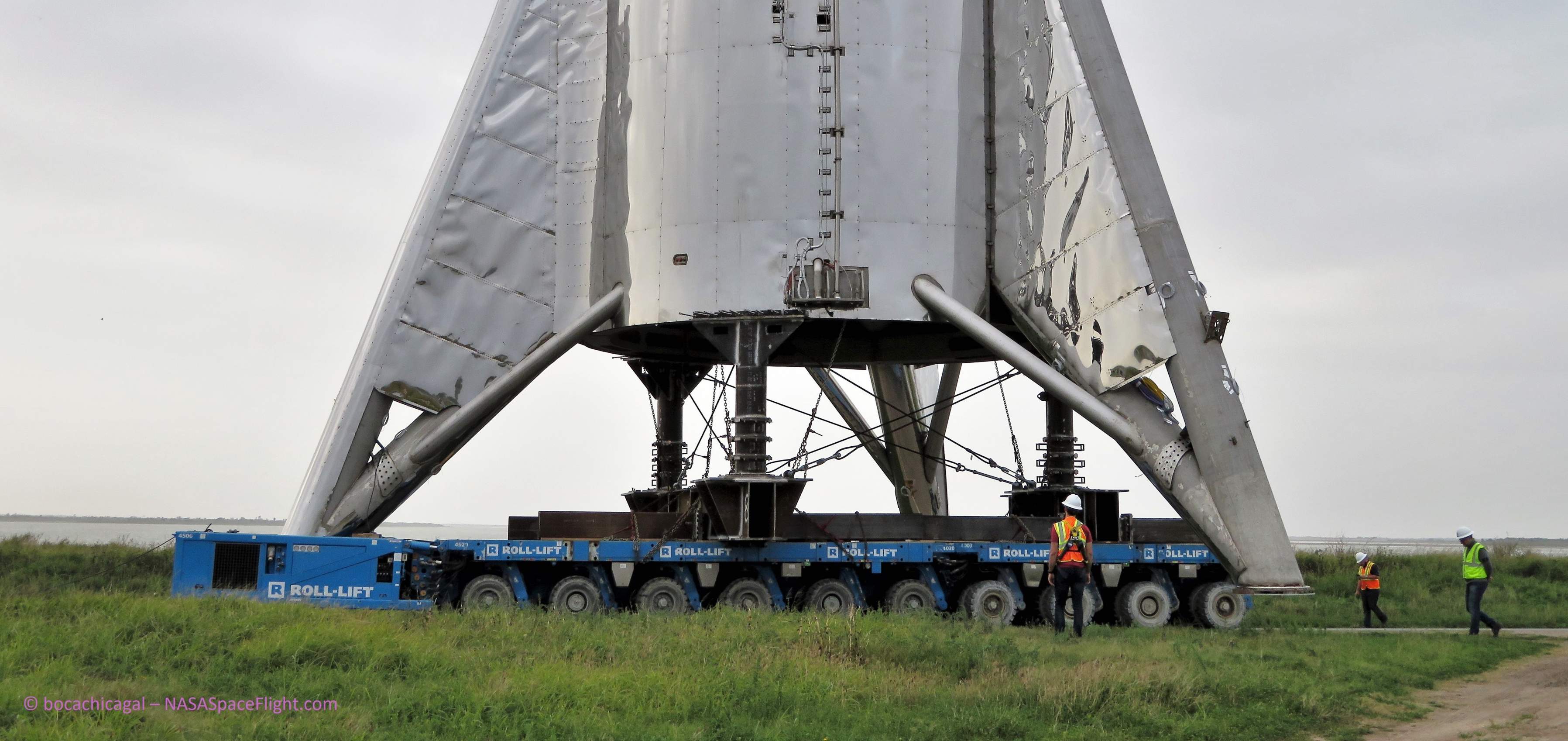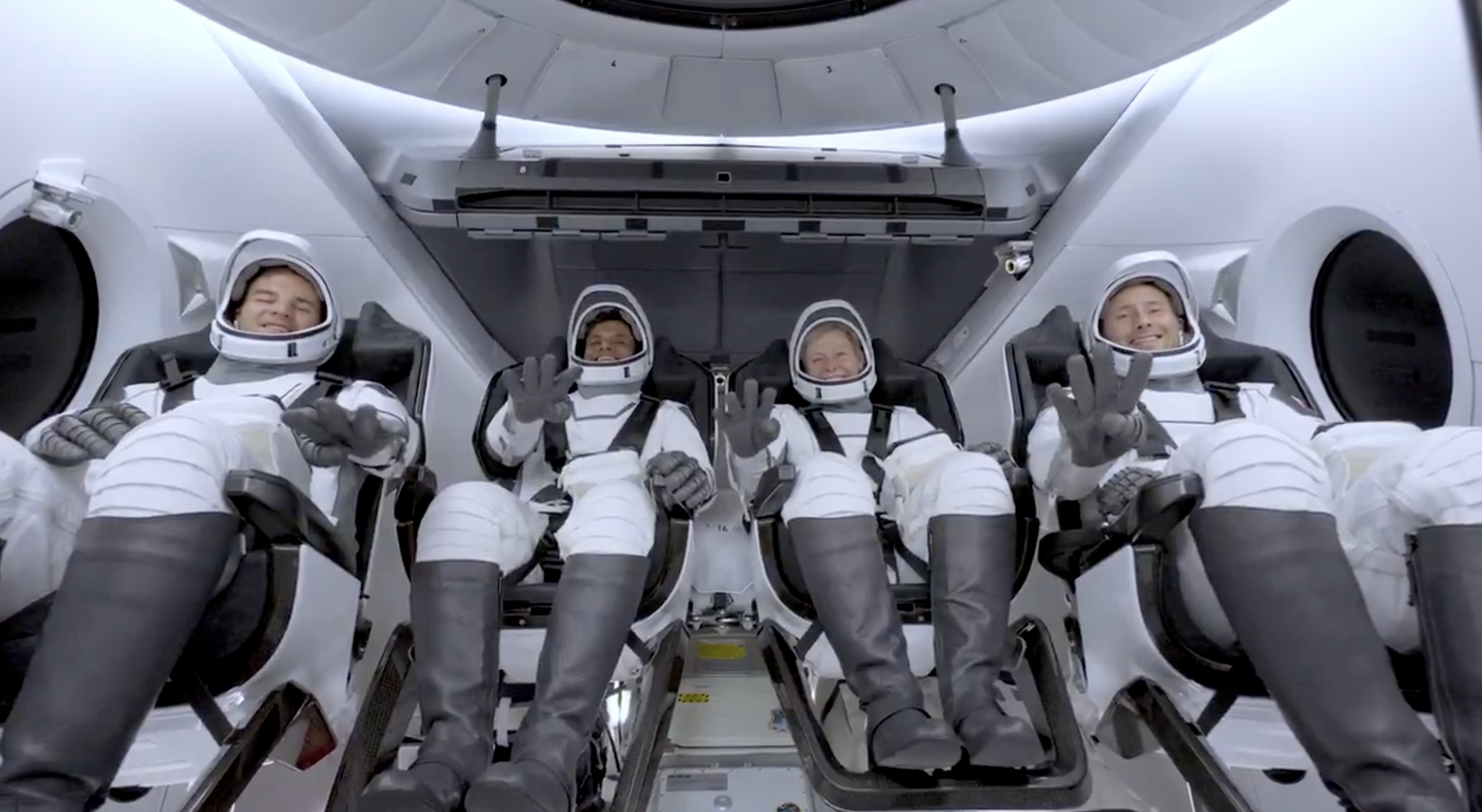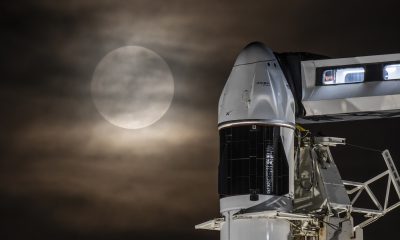

SpaceX
SpaceX’s Starship prototype moved to launch pad on new rocket transporter
Over the last two or so weeks, SpaceX engineers and technicians have continued to make progress on the company’s first full-scale Starship prototype, intended to support experimental suborbital hop tests as early as March or April.
That work reached a peak on March 8th when the massive Starhopper was transported from build site to launch pad on a brand new transporter that was delivered and assembled barely 48 hours prior. Ahead of the suborbital prototype’s move, work has been ongoing to construct a replacement fairing for the partial-fidelity vehicle, although there is a chance that the new BFR-related stainless steel sections being assembled could be the start of the first orbital Starship prototype.
Required after improper planning destroyed Starship’s original nosecone (or fairing) when it broke free from its insufficient moorings during high coastal winds, the replacement has sprouted from sheets of metal into a far more substantial structure in barely two weeks. Designed as two integral parts of a suborbital Starship prototype, the upper section (i.e. fairing, nosecone, etc.) is predominately a passive aerodynamic structure with no major active functions, thankfully meaning that the first article’s accidental destruction was a relatively minor loss.
In fact, it’s entirely possible that the fairing’s demise has had a minimal impact on the commencement of hop tests, and may have even been a net-good for the program given some visible differences between Starship fairings #1 and #2. Despite the fact that the first fairing was destroyed in late January and a comment from CEO Elon Musk indicating that it would trigger a delay of a few weeks, SpaceX did not begin to assemble its replacement until February 21st, a full month later. Over the course of those 30 or so days, the company’s propulsion team simultaneously began hot-fire tests of the first full-scale Raptor engine, ramped thrust and chamber pressure from roughly 40 to 100 percent, and ultimately pushed the engine to the point of damage around the second week of February.
Work on the primary structure of the Starship prototype also proceeded apace, fleshing out the brute-force steel vehicle with the beginnings of serious avionics and plumbing and more or less completing the structure of its liquid oxygen and methane propellant tanks. SpaceX workers also rapidly expanded and built-out Starship’s prospective hop test launch pad just a few thousand feet distant, installing tank farms, piping, water deluge hardware, and building an actual concrete ‘pad’ with umbilical connection ports and attachment points for the ship’s three fin-legs.

Welding and assembly of the replacement nosecone began around February 21st, rapidly growing from a few sheets of steel to a nearly-complete barrel section measuring about 9m tall and 9m in diameter (30ft x 30ft). Intriguingly, the new fairing appears to be a significant departure from the structural composition of its predecessor, utilizing far thicker sheets of stainless steel joined by uninterrupted width and lengthwise welds. Compared to the first fairing’s dependence on extremely thin (nearly foil-like) steel sheets and a separate internal framework of metal bars, Starship fairing V2 appears to be easily capable of standing under its own weight and then some. While largely passive, it’s likely that once the structure is complete, some level of additional avionics (and perhaps cold or hot-gas maneuvering thrusters) will be installed inside.
Heres a close up of the launch site. pic.twitter.com/Q32SHjUH8F— RGVAerialPhotography (@RGVaerialphotos) March 4, 2019
U-Crawl
Keeping in the practice of dramatically lowering costs by prioritizing consumer off-the-shelf (COTS) hardware solutions wherever possible, SpaceX has purchased or leased a quartet of (likely used) crawlers for the purpose of transporting Starship between the company’s South Texas build, launch, and landing sites. Built by a European conglomerate known TII Group and owned by US-based Roll Group, SpaceX’s four crawlers – coupled to form a duo of larger crawlers – should be more than capable of transporting anywhere from 500t to 1000t or more, easily supporting Starhopper and/or Starships and Super Heavy boosters.

Rather than spending huge amounts of money to develop or contract out a custom-designed crawler or transporter solution for BFR, SpaceX appears to have simply purchased off-the-shelf hardware and affixed them with heavy steel structures capable of securing and supporting Starhopper during transport. Within 24 hours of the crawler arrivals, those beams were installed and the transporter had been moved underneath Starhopper and attached to it before quite literally jacking the massive ship off the ground, allowing technicians to weld additional structures to the tips of its three legs.

Last but not least…
Perhaps most curious of all, Starhopper’s replacement fairing was recently joined by the start of work on a separate barrel section that appears to be nearly identical. Assuming the presumed fairing is, in fact, a fairing-to-be, the combined height of the two barrel sections would already make it significantly taller than the original nosecone, and the beginning of the conical taper has yet to appear on either assembly. This could generally mean one of two things. First, the new fairing could make Starhopper much taller than its short-lived predecessor. Second, SpaceX could be planning to begin (or even complete) hop tests without a fairing, in which case the presumed fairing and its slightly younger twin could actually be the beginning of a higher-fidelity Starhopper or even the orbital Starship prototype hinted at by Musk earlier this year.
While far less likely than the first option, the latter alternative is further supported by the fact that visible work has begun on some sort of tapered or curved steel complements to the new sections in work. While they certainly could be the beginning of the fairing’s tapered cone, the latest segments only loosely resemble the start of a gradual curve. Instead, they look similar to the steel segments of several giant tank domes that were assembled, welded, and installed inside Starhopper last month.


On March 8th, SpaceX began the transport of its first full-scale Starship prototype at the same time as CEO Elon Musk indicated that the first flightworthy Raptor(s) would be delivered to South Texas and installed on the hop test article as early as next week (March 11-17). It’s now looking increasingly likely that any replacement fairing that may or may not be under construction might not be ready for installation on Starhopper before SpaceX begins integrated static-fire tests and maybe even low-altitude tethered hop tests.
“SpaceX will conduct checkouts of the newly installed ground systems and perform a short static fire test in the days ahead,” he said. “Although the prototype is designed to perform sub-orbital flights, or hops, powered by the SpaceX Raptor engine, the vehicle will be tethered during initial testing and hops will not be visible from offsite. SpaceX will establish a safety zone perimeter in coordination with local enforcement and signage will be in place to alert the community prior to the testing.” – James Gleeson, March 8th, SpaceX
Check out Teslarati’s Marketplace! We offer Tesla accessories, including for the Tesla Cybertruck and Tesla Model 3.
News
SpaceX launches Ax-4 mission to the ISS with international crew
The SpaceX Falcon 9 launched Axiom’s Ax-4 mission to ISS. Ax-4 crew will conduct 60+ science experiments during a 14-day stay on the ISS.

SpaceX launched the Falcon 9 rocket kickstarting Axiom Space’s Ax-4 mission to the International Space Station (ISS). Axiom’s Ax-4 mission is led by a historic international crew and lifted off from Kennedy Space Center’s Launch Complex 39A at 2:31 a.m. ET on June 25, 2025.
The Ax-4 crew is set to dock with the ISS around 7 a.m. ET on Thursday, June 26, 2025. Axiom Space, a Houston-based commercial space company, coordinated the mission with SpaceX for transportation and NASA for ISS access, with support from the European Space Agency and the astronauts’ governments.
The Ax-4 mission marks a milestone in global space collaboration. The Ax-4 crew, commanded by U.S. astronaut Peggy Whitson, includes Shubhanshu Shukla from India as the pilot, alongside mission specialists Sławosz Uznański-Wiśniewski from Poland and Tibor Kapu from Hungary.
“The trip marks the return to human spaceflight for those countries — their first government-sponsored flights in more than 40 years,” Axiom noted.
Shukla’s participation aligns with India’s Gaganyaan program planned for 2027. He is the first Indian astronaut to visit the ISS since Rakesh Sharma in 1984.
Axiom’s Ax-4 mission marks SpaceX’s 18th human spaceflight. The mission employs a Crew Dragon capsule atop a Falcon 9 rocket, designed with a launch escape system and “two-fault tolerant” for enhanced safety. The Axiom mission faced a few delays due to weather, a Falcon 9 leak, and an ISS Zvezda module leak investigation by NASA and Roscosmos before the recent successful launch.
As the crew prepares to execute its scientific objectives, SpaceX’s Ax-4 mission paves the way for a new era of inclusive space research, inspiring future generations and solidifying collaborative ties in the cosmos. During the Ax-4 crew’s 14-day stay in the ISS, the astronauts will conduct nearly 60 experiments.
“We’ll be conducting research that spans biology, material, and physical sciences as well as technology demonstrations,” said Whitson. “We’ll also be engaging with students around the world, sharing our experience and inspiring the next generation of explorers.”
SpaceX’s Ax-4 mission highlights Axiom’s role in advancing commercial spaceflight and fostering international partnerships. The mission strengthens global space exploration efforts by enabling historic spaceflight returns for India, Poland, and Hungary.
News
Starlink Cellular’s T-Mobile service to grow with third-party app data
From Oct 2025, T-Satellite will enable third-party apps in dead zones! WhatsApp, X, AccuWeather + more coming soon.

Starlink Cellular’s T-Mobile service will expand with third-party app data support starting in October, enhancing connectivity in cellular dead zones.
T-Mobile’s T-Satellite, supported by Starlink, launches officially on July 23. Following its launch, T-Mobile’s Starlink Cellular service will enable data access for third-party apps like WhatsApp, X, Google, Apple, AccuWeather, and AllTrails on October 1, 2025.
T-Mobile’s Starlink Cellular is currently in free beta. T-Satellite will add MMS support for Android phones on July 23, with iPhone support to follow. MMS support allows users to send images and audio clips alongside texts. By October, T-Mobile will extend emergency texting to all mobile users with compatible phones, beyond just T-Mobile customers, building on its existing 911 texting capability. The carrier also provides developer tools to help app makers integrate their software with T-Satellite’s data service, with plans to grow the supported app list.
T-Mobile announced these updates during an event celebrating an Ookla award naming it the best U.S. phone network, a remarkable turnaround from its last-place ranking a decade ago.
“We not only dream about going from worst to best, we actually do it. We’re a good two years ahead of Verizon and AT&T, and I believe that lead is going to grow,” said T-Mobile’s Chief Operating Officer Srini Gopalan.
T-Mobile unveiled two promotions for its Starlink Cellular services to attract new subscribers. A free DoorDash DashPass membership, valued at $10/month, will be included with popular plans like Experience Beyond and Experience More, offering reduced delivery and service fees. Meanwhile, the Easy Upgrade promotion targets Verizon customers by paying off their phone balances and providing flagship devices like the iPhone 16, Galaxy S25, or Pixel 9.
T-Mobile’s collaboration with SpaceX’s Starlink Cellular leverages orbiting satellites to deliver connectivity where traditional networks fail, particularly in remote areas. Supporting third-party apps underscores T-Mobile’s commitment to enhancing user experiences through innovative partnerships. As T-Satellite’s capabilities grow, including broader app integration and emergency access, T-Mobile is poised to strengthen its lead in the U.S. wireless market.
By combining Starlink’s satellite technology with strategic promotions, T-Mobile is redefining mobile connectivity. The upcoming third-party app data support and official T-Satellite launch mark a significant step toward seamless communication, positioning T-Mobile as a trailblazer in next-generation wireless services.
News
Starlink expansion into Vietnam targets the healthcare sector
Starlink aims to deliver reliable internet to Vietnam’s remote clinics, enabling telehealth and data sharing.

SpaceX’s Starlink expansion into Vietnam targets its healthcare sector. Through Starlink, SpaceX seeks to drive digital transformation in Vietnam.
On June 18, a SpaceX delegation met with Vietnam’s Ministry of Health (MoH) in Hanoi. SpaceX’s delegation was led by Andrew Matlock, Director of Enterprise Sales, and the discussions focused on enhancing connectivity for hospitals and clinics in Vietnam’s remote areas.
Deputy Minister of Health (MoH) Tran Van Thuan emphasized collaboration between SpaceX and Vietnam. Tran stated: “SpaceX should cooperate with the MoH to ensure all hospitals and clinics in remote areas are connected to the StarLink satellite system and share information, plans, and the issues discussed by members of the MoH. The ministry is also ready to provide information and send staff to work with the corporation.”
The MoH assigned its Department of Science, Technology, and Training to work with SpaceX. Starlink Vietnam will also receive support from Vietnam’s Department of International Cooperation. Starlink Vietnam’s agenda includes improving internet connectivity for remote healthcare facilities, developing digital infrastructure for health examinations and remote consultations, and enhancing operational systems.
Vietnam’s health sector is prioritizing IT and digital transformation, focusing on electronic health records, data centers, and remote medical services. However, challenges persist in deploying IT solutions in remote regions, prompting Vietnam to seek partnerships like SpaceX’s.
SpaceX’s Starlink has a proven track record in healthcare. In Rwanda, its services supported 40 health centers, earning praise for improving operations. Similarly, Starlink enabled remote consultations at the UAE’s Emirati field hospital in Gaza, streamlining communication for complex medical cases. These successes highlight Starlink’s potential to transform Vietnam’s healthcare landscape.
On May 20, SpaceX met with Vietnam’s Ministry of Industry and Trade, announcing a $1.5 billion investment to provide broadband internet, particularly in remote, border, and island areas. The first phase includes building 10-15 ground stations across the country. This infrastructure will support Starlink’s healthcare initiatives by ensuring reliable connectivity.
Starlink’s expansion in Vietnam aligns with the country’s push for digital transformation, as outlined by the MoH. By leveraging its satellite internet expertise, SpaceX aims to bridge connectivity gaps, enabling advanced healthcare services in underserved regions. This collaboration could redefine Vietnam’s healthcare infrastructure, positioning Starlink as a key player in the nation’s digital future.
-

 Elon Musk3 days ago
Elon Musk3 days agoTesla investors will be shocked by Jim Cramer’s latest assessment
-

 News1 week ago
News1 week agoTesla Robotaxi’s biggest challenge seems to be this one thing
-

 News2 weeks ago
News2 weeks agoTexas lawmakers urge Tesla to delay Austin robotaxi launch to September
-

 Elon Musk2 weeks ago
Elon Musk2 weeks agoFirst Look at Tesla’s Robotaxi App: features, design, and more
-

 Elon Musk2 weeks ago
Elon Musk2 weeks agoxAI’s Grok 3 partners with Oracle Cloud for corporate AI innovation
-

 News2 weeks ago
News2 weeks agoSpaceX and Elon Musk share insights on Starship Ship 36’s RUD
-

 News2 weeks ago
News2 weeks agoWatch Tesla’s first driverless public Robotaxi rides in Texas
-

 News2 weeks ago
News2 weeks agoTesla has started rolling out initial round of Robotaxi invites


















